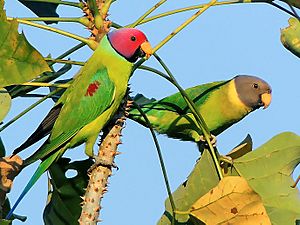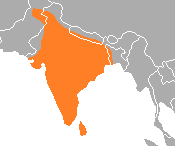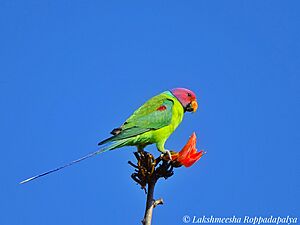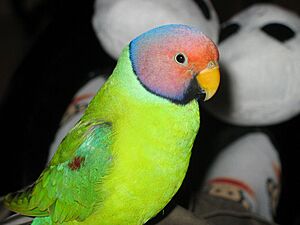Plum-headed parakeet facts for kids
Quick facts for kids Plum-headed parakeet |
|
|---|---|
 |
|
| A male and female. | |
| Conservation status | |
| Scientific classification | |
| Genus: |
Psittacula
|
| Species: |
cyanocephala
|
 |
|
| Distribution range of plum-headed parakeet | |
| Synonyms | |
|
|
The plum-headed parakeet (Psittacula cyanocephala) is a beautiful bird from the parakeet family. These birds live only in the Indian Subcontinent. People once thought they were the same as the blossom-headed parakeet. However, scientists now know they are a separate species.
Plum-headed parakeets often fly in groups. The male birds have a pinkish-purple head. The females have a grey head. They fly very fast, making quick turns and special calls.
Contents
Understanding Plum-headed Parakeet Names
Scientists give every animal a unique name. This helps everyone know exactly which animal they are talking about. The plum-headed parakeet's scientific name is Psittacula cyanocephala.
A French scientist named Mathurin Jacques Brisson first described this bird in 1760. He gave it a Latin name, but it wasn't the official kind we use today. Later, in 1766, a Swedish scientist named Carl Linnaeus gave the bird its official scientific name, Psittacus cyanocephalus.
The name cyanocephalus comes from ancient Greek words. "Kuanos" means "dark-blue," and "kephalos" means "headed." This name describes the bird's head color. Today, this parakeet is part of the Psittacula group of birds.
Plum-headed Parakeet Appearance
Plum-headed parakeets are mostly green. They grow to about 33 centimeters (13 inches) long. Their tail can be up to 22 centimeters (8.7 inches) long.
Male and Female Differences
The male parakeet has a striking head. It is red and fades to purple-blue on the back of its head and cheeks. Males also have a thin black ring around their neck. Below this, the neck is greenish-blue. They have a black stripe under their chin. A red patch is visible on their shoulder. Their upper beak is orange-yellow, and the lower beak is dark.
The female parakeet looks a bit different. Her head is a dull bluish-grey. She does not have the black or greenish-blue neck ring. Instead, her neck is yellow. Females also lack the black chin stripe and the red shoulder patch. Her upper beak is yellow.
Young Parakeets
Young plum-headed parakeets have green heads. Both their upper and lower beaks are yellowish. Their heads change color to the adult shades after about one year.
How Their Colors Work
The beautiful bluish-red color on their heads is special. It comes from two things. Blue color is made by how light reflects off their feathers. A red color comes from a special pigment inside the feathers.
Similar Birds
The plum-headed parakeet looks a bit like the blossom-headed parakeet. However, you can tell them apart. The plum-headed parakeet has a different head color and a white tip on its tail. The blossom-headed parakeet has a maroon shoulder patch and a shorter tail with a yellow tip.
Where Plum-headed Parakeets Live
Plum-headed parakeets live in forests and open woodlands. You can even find them in city gardens. They live from the foothills of the Himalayas all the way south to Sri Lanka. They do not live in the dry areas of western India.
Sometimes, these birds are kept as pets. If they escape, they can start new groups. Escaped birds have been seen in places like New York, Florida, and parts of the Middle East.
Plum-headed Parakeet Behavior and Life Cycle
Plum-headed parakeets are social birds. They are often noisy and make many different loud calls. Their usual call sounds like "tuink?" and they repeat it often. They fly very fast, twisting and turning quickly in the air.
Diet and Food
These birds move around a lot. They follow where they can find food. They eat grains, fruits, and the soft petals of flowers. Sometimes, they visit farms and fruit orchards to find food.
Reproduction and Nests
The breeding season in India is usually from December to April. In Sri Lanka, it is from July to August. During courtship, the male and female rub their beaks together. They also feed each other.
Plum-headed parakeets make their nests in holes in tree trunks. The male and female work together to make the hole bigger. The female lays 4 to 6 white eggs. She is usually the only one who sits on the eggs to keep them warm. She also feeds the young birds.
These parakeets sleep together in large groups. In captivity, they can learn to copy sounds like beeps and whistles. Some can even learn to talk very well!
Ancient History of Talking Parakeets
Long ago, around 400 BC, a Greek doctor named Ctesias wrote about India. He worked for the Persian emperor. In his writings, he described a bird that sounds like the plum-headed parakeet. He likely saw this bird himself with an Indian handler.
Ctesias wrote that this bird, called a "bittakos," could talk like a human. He said it was the size of a falcon. It had a crimson (deep red) face and a black beard. Its body was dark blue, like a special red color called cinnabar. He said it could speak in Indian languages. If taught Greek, it could speak Greek too! This shows that people have been amazed by these talking birds for a very long time.





